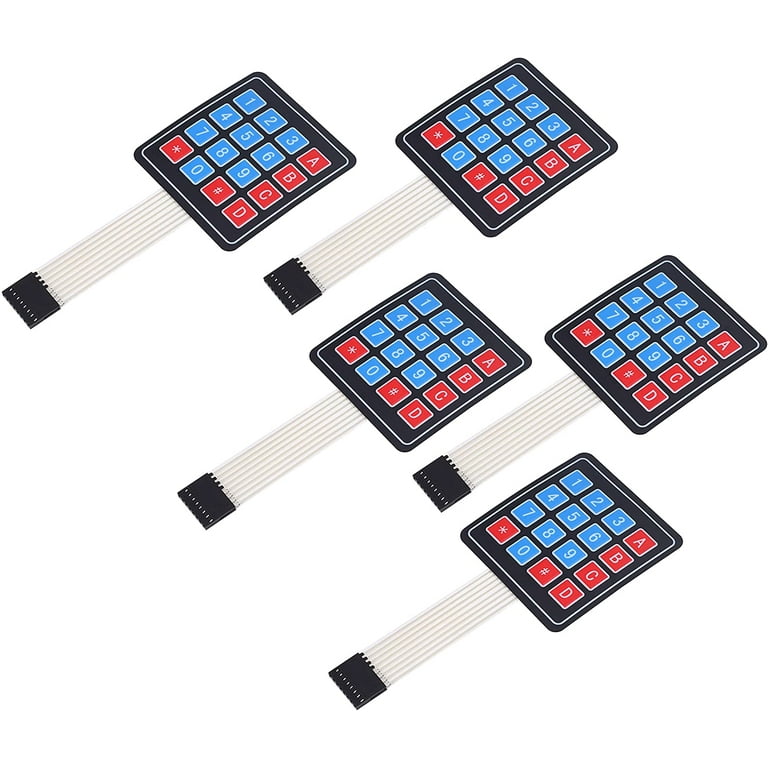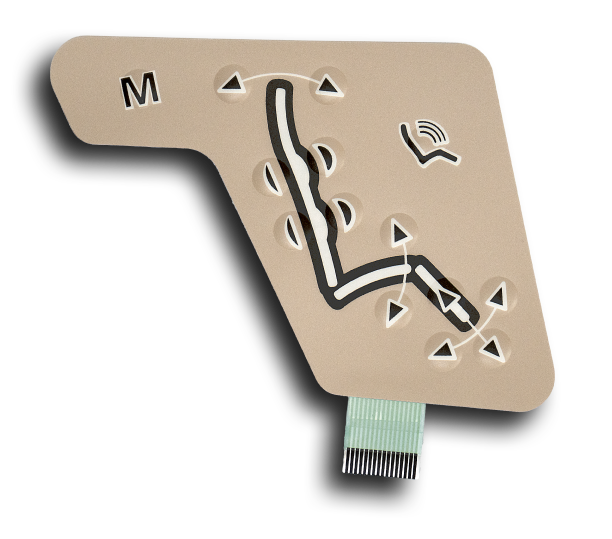Membrane Switch Manufacturer Specializing in Custom Product Integration
Membrane Switch Manufacturer Specializing in Custom Product Integration
Blog Article
Discovering the Production Refine of Membrane Switch for Numerous Industries
The production procedure of Membrane buttons is a complicated undertaking that demands precision and interest to detail. From selecting appropriate products to applying strenuous quality assurance steps, each step plays a vital function in guaranteeing performance. Various sectors, consisting of medical and auto, rely upon these parts for their special applications. Understanding the intricacies of this procedure exposes significant understandings into just how these switches are created and their impact throughout diverse industries.
Understanding Membrane Switches: An Overview

Key Products Made Use Of in Membrane Switch Manufacturing
In Membrane button manufacturing, the selection of key products considerably influences functionality and longevity. Conductive products, adhesives, and finishings play vital functions, while substratum selection influences general efficiency and dependability. Recognizing these elements is crucial for enhancing the layout and production of Membrane buttons.
Conductive Materials Overview
Conductive products play a vital duty in the capability of Membrane switches, making certain dependable electric links within the gadget. Typically utilized products consist of silver, copper, and carbon-based inks, each offering distinct benefits. Silver is preferred for its high conductivity and resilience, making it suitable for applications needing robust efficiency. Copper, while slightly less conductive than silver, is a cost-efficient alternative frequently used in printed circuits. Carbon-based inks supply a flexible alternative, suitable for applications where flexibility and lower costs are prioritized, although they have reduced conductivity compared to steel alternatives. The choice of conductive products straight impacts the overall dependability, life expectancy, and performance of the Membrane switch, making it a crucial consideration in the manufacturing procedure.
Adhesives and Coatings
Adhesives and coverings are important parts in the production of Membrane switches, offering vital bonding and safety properties. These materials ensure that various layers of the button, including visuals overlays and circuitry, adhere firmly to one an additional, boosting durability and functionality. Typically used adhesives consist of pressure-sensitive adhesives (PSAs) and epoxy-based formulations, which provide strong bond and resilience. Coatings, such as polyurethane or acrylic, serve to shield versus environmental variables, consisting of dampness, abrasion, and chemicals. In addition, coatings can enhance responsive comments and visual allure, adding to the overall customer experience. The choice of proper adhesives and finishes is critical for maximizing efficiency and long life in varied applications across various industries, making sure that Membrane switches fulfill details operational needs.
Substrate Choice Factors
Substrate selection plays an important role in the manufacturing of Membrane buttons, as it considerably influences their general performance and resilience. Trick materials such as polyester, polycarbonate, and flexible printed circuit boards (FPCBs) are generally utilized for their distinct residential properties. Polyester is favored for its cost-effectiveness and resistance to abrasion, making it suitable for applications with high wear. Polycarbonate deals superior clearness and influence resistance, perfect for environments needing high visibility. FPCBs offer boosted adaptability and are frequently utilized in complex layouts. The option of substratum additionally affects variables like thermal security, chemical resistance, and ease of printing. Eventually, selecting the ideal substrate is vital for making certain the functionality and durability of Membrane switches across numerous sectors.
The Layout Process of Membrane Switches Over
The style procedure of Membrane buttons is a crucial stage that significantly affects the capability and looks of the last product - membrane switch manufacturer. It starts with specifying the particular demands of the application, consisting of measurements, button format, and tactile comments preferences. Designers should consider customer interaction, ensuring that the button is instinctive and accessible.Next, products are selected based on toughness, adaptability, and ecological resistance. The assimilation of graphics and branding components is likewise crucial, as it enhances visual charm and interaction. Prototyping permits repetitive testing, making it possible for modifications based upon customer comments and efficiency evaluations.Additionally, the design needs to make up the electric elements, such as connectors and circuits, guaranteeing dependability and convenience of use. Eventually, an effective style balances functionality, aesthetics, and individual experience, paving the way for efficient manufacturing and lasting performance in numerous markets
Printing Techniques for Membrane Changes
The printing methods used in Membrane switch manufacturing play an important role in determining the end product's quality and performance. Screen printing supplies advantages such as durability and vibrant shade application, while electronic printing technologies supply adaptability and precision in design. Comprehending these approaches can significantly influence the total performance of Membrane switches in numerous applications.
Display Printing Advantages
Various benefits make screen publishing a preferred method for producing Membrane switches. This approach enables for high-grade, in-depth designs and vibrant shades, which are vital for customer interface applications. Screen printing is especially efficient for using thick ink layers, enhancing resilience and responsive responses. On top of that, it provides superb attachment to different substratums, making sure durability popular settings. The procedure is cost-effective for large manufacturing runs, as it minimizes arrangement time and waste. Screen printing sustains a wide array of inks, consisting of specialty and UV-curable alternatives, making it possible for adaptability in layout. Its capacity to generate regular outcomes across multiple units makes it a reliable selection for makers aiming for top quality and efficiency in Membrane switch manufacturing.
Digital Printing Innovations

Innovations in digital printing innovation are changing the production of Membrane buttons, supplying producers innovative services that enhance design adaptability and performance. Digital printing enables high-resolution graphics and complex designs, enabling customized branding and performance without the restrictions of typical methods. This technique minimizes arrangement times and prices, facilitating shorter production runs and minimal waste, making it suitable for organizations with differing needs. Additionally, advancements in ink formulations offer far better sturdiness and bond, making sure long life in numerous atmospheres. As markets progressively seek customized and complicated styles, digital printing stands apart as a vital method, setting a brand-new criterion in Membrane switch production. The assimilation of these advancements settings manufacturers to fulfill advancing market requires efficiently.
Setting up and Layering of Membrane Switch Elements
Mindful setting up and layering of Membrane switch parts are vital to assuring performance and longevity. This procedure begins with the specific positioning of various layers, consisting of the graphic overlay, glue, circuit layer, and backing product. Each element must be meticulously positioned to keep electric integrity and interface responsiveness.During assembly, conductive traces are used to the circuit layer, generally made from products like polyester or polycarbonate. This layer is vital, as it sends signals when pressure is used. The adhesive utilized for bonding these layers is also selected for its capacity to withstand environmental tensions while keeping a protected bond.Heat and stress are frequently used throughout the assembly procedure to identify that the layers adhere appropriately without compromising the performance of the button. Attention is provided to the side securing to shield against wetness and contaminants, securing the durability of the Membrane switch in different commercial applications.
Top Quality Control Actions in Membrane Switch Manufacturing
Quality control measures play a vital duty in making certain the integrity and efficiency of Membrane switches over adhering to the setting up and layering of their parts. In the manufacturing procedure, a number of crucial examinations are performed to promote top quality criteria. These consist of visual evaluations for problems in printing and adhesive application, as well as useful tests to confirm the responsiveness of each switch.Additionally, environmental screening is executed to analyze the switches' sturdiness against temperature variations and moisture exposure. Manufacturers often implement analytical process control (copyright) techniques to monitor manufacturing consistency, enabling very early detection of anomalies.Furthermore, traceability systems are developed to track elements and materials, making certain responsibility and facilitating remembers if required. Calibration of tools and adherence to market standards are additionally essential to maintaining item integrity. Collectively, these quality assurance Learn More Here procedures guard the performance of Membrane switches over across different applications, inevitably boosting customer satisfaction.
Applications of Membrane Switches Throughout Different Industries
Membrane buttons are utilized throughout a diverse variety of markets, showcasing their flexibility and versatility. In the medical field, they provide reliable and waterproof user interfaces for tools such as diagnostic equipment and mixture pumps, ensuring health and ease of use. The automotive sector utilizes Membrane buttons for control panel controls, making it possible for seamless communication in between the driver and automobile systems.In customer electronics, these switches are discovered in devices and handheld devices, using a smooth, modern visual while boosting functionality. Industrial applications additionally leverage Membrane changes for machinery control board, where toughness and resistance to severe conditions are essential.Furthermore, the aerospace and protection industries make use of Membrane buttons for cockpit instrumentation and interaction systems, focusing on reliability and performance under severe conditions. Overall, Membrane switches play a vital duty in boosting the individual experience and operational effectiveness across different domain names.
Often Asked Questions
For how long Does It Take to Manufacture a Membrane Layer Switch?
The production time for a membrane layer switch commonly ranges from a few days to several weeks - membrane switch manufacturer. Variables influencing this duration consist of layout intricacy, product availability, and production volume, all impacting the overall timeline significantly
What Is the Common Life-span of a Membrane Switch?
The typical life-span of a membrane layer button typically ranges from 1 to 5 million actuations, depending upon aspects such as worldly quality, ecological problems, and usage regularity, considerably impacting sturdiness and overall performance.
Can Membrane Switches Be Customized for Specific Applications?
Membrane buttons can undoubtedly be customized for specific applications. Their style versatility enables changes in size, form, shades, and graphics, making certain compatibility with special needs throughout different industries and enhancing capability and customer experience.

Are Membrane Switches Over Eco-friendly?
The environmental impact of Membrane switches varies. Some products made use of might not be environment-friendly, while innovations in producing procedures are progressively focusing on sustainability, intending to reduce waste and advertise recyclable components in their manufacturing.
What Are the Common Failure Modes of Membrane Buttons?
Typical failing modes of Membrane switches include delamination, sticky failing, damage from use, dampness ingress, and electric failings. These issues can greatly influence performance, performance, and life expectancy in numerous applications throughout different markets. Membrane switches can be customized discover this info here to fit certain design needs, such as size, these details form, and performance, making them very adaptable.The building and construction normally involves numerous layers, including a visuals overlay, glue, and a circuit layer, which function together to develop a seamless individual experience. In Membrane button manufacturing, the choice of vital products significantly affects capability and durability. The automobile industry uses Membrane buttons for dashboard controls, allowing smooth communication between the chauffeur and car systems.In customer electronic devices, these switches are found in home appliances and handheld gadgets, supplying a streamlined, modern visual while boosting functionality. Industrial applications additionally take advantage of Membrane changes for equipment control panels, where durability and resistance to rough conditions are essential.Furthermore, the aerospace and protection fields make use of Membrane switches for cabin instrumentation and communication systems, focusing on integrity and performance under severe problems. Membrane switches can indeed be customized for particular applications.
Report this page